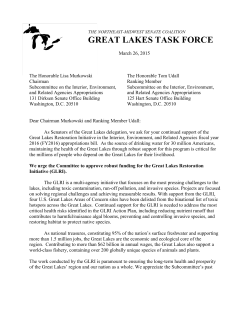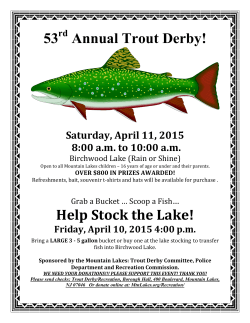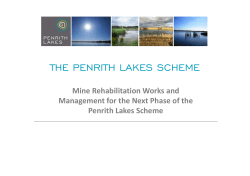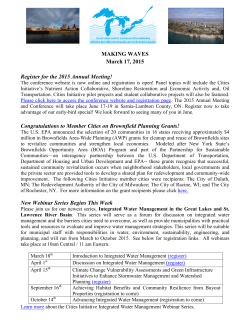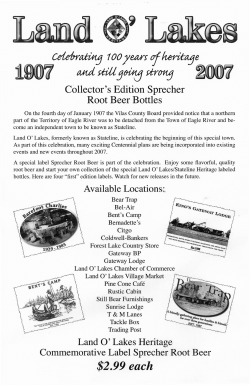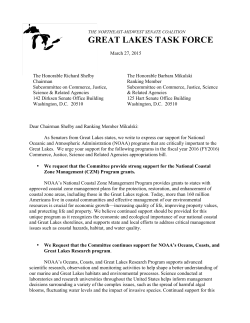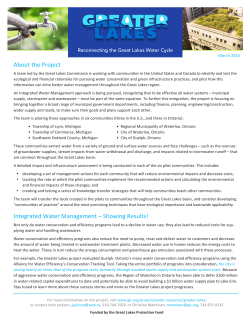
Request for Proposal - USDA Forest Service
FINAL – 021015 Request for Proposals (RFP) Fiscal Year 2015 Northeastern Area State and Private Forestry Great Lakes Restoration Initiative (GLRI) Reply Due March 23, 2015 to GLRI@fs.fed.us Background and Purpose The interagency Great Lakes Restoration Initiative (GLRI) targets improvements to the most significant environmental problems within the Great Lakes basin. Through an agreement with the Environmental Protection Agency (EPA), the US Forest Service has received funding to support projects that implement strategic, priority actions within Forest Service authorities to restore, protect, and maintain the Great Lakes ecosystem. Successful projects will address near-shore health and nonpoint source pollution, green infrastructure, invasive species, and toxic substances that impact water quality in priority watersheds or those that drain to identified Areas of Concern.1 Available funds are distributed across three specific program areas: Program Area 1. Mitigate Emerald Ash Borer (EAB) Impacts - Ash tree replacement with non-host species in urban EAB quarantine areas to protect and restore biodiversity and water quality in targeted sub-watersheds, and to reduce soil erosion and nutrient runoff (esp. phosphorus). 2. Reduce Toxic Substances in Brownfield Sites – Plant site-appropriate trees and vegetation to remediate certain toxic substances and restore green infrastructure that will reduce storm-water runoff. 3. Reduce Runoff from Degraded Sites through Green Infrastructure – Protect and restore watersheds through improved green infrastructure using trees and other vegetation to reduce storm water runoff on degraded sites on nonfederal lands. Estimated Funding $1,000,000 GLRI Focus Areas Invasive Species $830,000 Toxic Substances and Areas of Concern Nonpoint Source Pollution Impacts on Nearshore Health $1,500,000 Eligibility State agencies, Tribal communities, non-profit organizations, academic partners, and municipalities are eligible for GLRI funding within the Great Lakes Basin of Illinois, Indiana, Michigan, Minnesota, New York, Ohio, Pennsylvania, and Wisconsin. Eligible applicants must consult with their appropriate State Forester or Tribal administrator (for federally recognized tribes) to develop and submit proposals. The Great Lakes Watershed is defined as those areas within the United States draining (surface, overflow, or groundwater) into either: Lake Superior, Lake Michigan2, Lake Huron, Lake Erie, or Lake Ontario or draining into the St. Lawrence River west of where the International Boundary line leaves the river. A map of the watershed including eligible counties with lands in the watershed is attached. To be successful, proposals must conform to the authorities of the Forest Service Cooperative Forestry Assistance Act. Proposals must follow Urban and Community Forestry (UCF) program authorities: “To plan for, establish, manage and protect trees, forests, green spaces and related natural resources in and adjacent to cities and towns” (http://www.federalgrantswire.com/urban-and-community-forestry-program.html). 1 2 Great Lakes Areas of Concern: http://epa.gov/greatlakes/aoc/index.html In Illinois, the Great Lakes Basin includes portions of Cook and Lake Counties as illustrated on the enclosed map. Reply due March 23, 2015 to GLRI@fs.fed.us Page 1 of 11 FINAL – 021015 Requirements and Evaluation Criteria Minimum Requirements All proposed projects must lie entirely within the Great Lakes watershed. Proposals must address: o A single Program Area (see Table, page 1); o Linkage to a specific Lakewide Action and Management Plan (see http://epa.gov/greatlakes/lamp/ ), or specific Remedial Action Plans for target AOCs (see http://epa.gov/greatlakes/aoc/); o Linkage to State Forest Action Plans (see http://www.forestactionplans.org/regional-state) Proposals must be fully implemented in the time proposed (two years from date of award) Eligible proposals must include documented support (letter or e-message) of State Forester or Tribal Administrator (for federally designated Tribes) for the project proposal. No match is required. However, the ability to demonstrate partnerships and to leverage funds will be an important consideration when proposals are reviewed. Emerald Ash Borer (EAB) mitigation projects are eligible only in EAB quarantined counties (see Map in Appendix C). The focus of these projects must be restoration of tree canopy cover, rather than removal. Landscape (nursery) tree planting proposals must follow guidance published and available on the Northeastern Area State and Private Forestry (NA S&PF) website http://www.na.fs.fed.us/fap/fap.shtm. Proposals must identify the number and size of proposed planting stock, and will be rated competitively, partially on the total cost per tree planted, including cost of warranty and/or maintenance to ensure all trees are in place and in good condition when inspected at the end of the project. Projects may occur only on non-federal land. GLRI requirements include quarterly progress reports with a final report due upon project completion. Awardees will be required to comply with all Federal laws and regulations related to the completion of projects as stated in the letter of award. Projects must post a visible project identification sign, erected as appropriate at each on-the-ground project, including: project information and purpose, GLRI reference, and federal agencies involved. Evaluation Criteria (Relative Weight) Addresses nearshore water quality issues in the Great Lakes watershed or in sub-watersheds draining into the Great Lakes (30%) – Scope of work specifically addresses a local watershed strategy for the protection, maintenance or restoration of the chemical, biological, or physical integrity of the Great Lakes basin. Addresses priority landscapes (30%) – Provides a clear connection to the State Forest Action Plan as well as the Great Lakes Action Plan, relevant Lakewide Action and Management Plan, or Remedial Action Plans addressing water quality. Priority will be given to project proposals for work in priority watersheds and those that drain to designated Areas of Concern (http://epa.gov/greatlakes/aoc/. Measurable results/outcomes expected (30%) – Includes specific units of work accomplished (number of trees planted) reported as a part of the project; and includes estimated outcomes contributing to improved water quality (acres treated or gallons of runoff captured or treated). Target tree canopy cover on EAB projects should equal or exceed current levels. Total cost per tree planted will be a factor in rating your proposal. Partnerships and other considerations (10%) – Projects should identify partners that have demonstrated a commitment (through a letter of support) and add value (quantitative or qualitative) towards project planning and implementation. Reply due March 23, 2015 to GLRI@fs.fed.us Page 2 of 11 FINAL – 021015 Grant Limits and Submission Instructions Proposals should be submitted separately under each of the three listed Program Areas. Program Area and Limits of Requested Federal Share 1. Mitigate Emerald Ash Borer (EAB) Impacts 2. Reduce Toxic Substances in Brownfield Sites 3. Reduce Runoff from Degraded Sites Minimum $50,000 $50,000 $50,000 Maximum $100,000 $200,000 $200,000 State Forestry agencies may consolidate these projects with other federal funds, but activities and accomplishments must be tracked and reported separately. Tribal Administrators are asked to send a copy of their GLRI proposal to the appropriate State Forester, as they submit their project proposal directly to the US Forest Service (GLRI@fs.fed.us) All partner recipients of federal funds should be clearly identified in the partner section of the application: name of organization and funding amount. The work responsibilities or sub-grant objectives of partner recipients should be clearly described in the project proposal. All proposals must include documented support (letter or e-message) of either the State Forester or Tribal Administrator. If you have questions, regarding the types of projects or components that can be considered, please contact your respective Field Office Representative: New York: Robert Clark, Acting Durham Field Office Representative at (603) 868-7716, or rclark01@fs.fed.us Ohio and Pennsylvania: Robert Lueckel, Morgantown Field Office Representative at (304) 285-1540, or rlueckel@fs.fed.us Mid-Western States: Carleen Yocum, St. Paul Field Office Representative at (651) 649-5276, or cyocum@fs.fed.us Additional information may also be obtained from Phillip Rodbell at (610) 577-4133, or prodbell@fs.fed.us Application instructions are enclosed. Please submit your proposals to GLRI@fs.fed.us in electronic form, no later than close of business on March 23, 2015. Reply due March 23, 2015 to GLRI@fs.fed.us Page 3 of 11 FINAL – 021015 Program Area Information Fiscal Year 2015 Northeastern Area State and Private Forestry Great Lakes Restoration Initiative (GLRI) Program Area: 1. Mitigate Emerald Ash Borer (EAB) Impact Great Lakes Restoration Initiative (GLRI) funds for this program area are intended to restore tree canopy lost to infestation by emerald ash borer. Replanting is critical to maintaining healthy, functioning tree canopy cover that will reduce and cool storm water flow, reduce soil erosion, and nutrient runoff (e.g. phosphorus), and protect water quality. Priority will be given to project proposals for work within communities that have adopted an EAB management plan (contact State Forester for more information and examples). Emphasis will be on working with communities and residents to mitigate EAB infestation by restoring diverse urban tree canopy cover on non-federal lands in urban and community areas. Target tree canopy cover replacement should equal or exceed levels prior to infestation. Landscape (nursery) tree planting proposals must follow guidance published and available on the Northeastern Area State and Private Forestry (NA S&PF) website http://www.na.fs.fed.us/fap/fap.shtm. Proposals must identify the number and size of proposed planting stock, and will be rated competitively, partially on the total cost per tree planted, including cost of warranty and/or maintenance to ensure all trees are in place and in good condition when inspected at the end of the project. Great Lakes Action Plan II: Focus Area 2: Invasive Species Objective 2: Control established invasive species. Commitment: Implement control projects for GLRI-targeted invasive species. Measure of Progress: Number of acres controlled by GLRI-funded projects (conversion factor average 100 trees/acre) Reply due March 23, 2015 to GLRI@fs.fed.us Page 4 of 11 FINAL – 021015 Program Area: 2. Reduce Toxic Substances in Brownfield Sites Great Lakes Restoration Initiative (GLRI) funds for this program can be utilized to address contaminants and toxic substances in degraded sites, including parking lots, through the restoration of green infrastructure and the planting of site-appropriate trees and vegetation to reduce, remove, degrade, or immobilize identified contaminants and reduce storm-water runoff. Priority will be given to grant proposals for work within priority watersheds and those that drain to designated Areas of Concern. Restoration of green infrastructure must be accomplished in accordance with a specifically designed plan to filter storm water and sediments or to remediate contaminated soil and groundwater. Great Lakes Action Plan I: Outcome: Focus Area 1, Toxic Substances and Areas of Concern Measure 5, pollution (in pounds) collected through prevention and waste minimization projects in the Great Lakes basin. Output: Number of acres treated and/or the number of trees planted to filter storm water runoff, or contain or control the migration of subsurface water. Program Area: 3. Reduce Runoff from Degraded Sites through Green Infrastructure Great Lakes Restoration Initiative (GLRI) funds for this program area intended to create or improve green infrastructure through the planting of trees and other vegetation as part of a local management strategy to protect and restore urban watersheds. Planting native and site-appropriate trees and other vegetation will capture and slow the flow of untreated runoff and contribute to filtering out sediments, nutrients, toxic contaminants, pathogens, and other pollutants prior to entering Great Lakes tributaries and nearshore waters. Federal authorities for this program do not include construction activities or laying foundations for permanent structures. Great Lakes Action Plan II: Focus Area 3: Nearshore Health and Nonpoint Source Pollution Objective 2: Reduce untreated runoff from urban watersheds. Commitment: Implement watershed management projects in urban areas that have adopted a watershed strategy. Measure of Progress: Projected volume (in gallons) of untreated urban runoff captured or treated by GLRI-funded projects over the first five years (conversion factor is 59 gallons per tree/year). Reply due March 23, 2015 to GLRI@fs.fed.us Page 5 of 11 FINAL – 021015 Application Instructions Fiscal Year 2015 Northeastern Area State and Private Forestry Great Lakes Restoration Initiative (GLRI) Project Applicant: Identify the entity responsible for conducting the fiscal and performance accountability of the project. The project applicant in most cases will be the grant award recipient. Contact Person: Provide the name(s) and contact information (address, phone, email) of the Project lead who will serve as principal contact for the project. Descriptive Title: Provide short title for future reference to the project. This must be the same title used on the Application for Federal Financial Assistance. Project Location: Provide GPS coordinates of project sites. Identify the priority watershed draining to a specific Area of Concern in which project activities will be targeted. Funds Requested: Applicant must identify amount of federal funds being requested. Program Area(s): Identify the GLRI Program Area your proposal addresses (3 choices). Project Duration: Projected starting and ending dates, not to exceed two (2) years from date of award. Overview: A short (100 word) summary of the project that includes the scope, location, expected accomplishments, and water quality benefits. Scope of Work: Provide a narrative (400 words) that outlines the methods employed to address the protection, maintenance or restoration of the chemical, biological or physical integrity of the Great Lakes watershed. (Planting efforts must follow guidance provided here: http://www.na.fs.fed.us/fap/fap.shtm) Priority Landscape: Provide information on the site location and its connection to water quality, including links to the State Forest Action Plan as well as the Great Lakes Action Plan, Lakewide Action and Management Plan, or Remedial Action Plans. Outcomes/Outputs Clearly list specific relevant outcomes and outputs from the project. NOTE: Tree planting proposals must specify the estimated number and size of trees. Partners: List and/or describe any partners who will be materially involved and their specific roles and contract amounts, if relevant. Attach letters of support, as appropriate. Time line: Provide a brief, approximate schedule showing intermediate steps and major milestones. Please indicate if a specific start date is critical. Project time line is not to exceed two (2) years from the date of award. Budget: Provide a proposed budget using the template provided in the application. Show primary budgeted activities and matching funds, if any. See Attached Form Reply due March 23, 2015 to GLRI@fs.fed.us Page 6 of 11 FINAL – 021015 Appendix A - Great Lakes Watershed Map Fiscal Year 2015 Northeastern Area State and Private Forestry Great Lakes Restoration Initiative (GLRI) Map Inset for Illinois and Indiana In Illinois and Indiana, for purposes of this RFP, the Great Lakes Basin includes the historic watersheds of the North Shore channel, Chicago and Little Calumet Rivers. This description was provided by EPA and supported by the IL DNR. Reply due March 23, 2015 to GLRI@fs.fed.us Page 7 of 11 FINAL – 021015 Appendix B - Counties Wholly or Partially in Great Lakes Watershed Fiscal Year 2015 Northeastern Area State and Private Forestry Great Lakes Restoration Initiative (GLRI) Counties Wholly in the Great Lakes Watershed Indiana DeKalb LaGrange Steuben Michigan Alcona Alger Allegan Alpena Antrim Arenac Baraga Barry Bay Benzie Branch Calhoun Cass Charlevoix Cheboygan Chippewa Clare Clinton Crawford Delta Dickinson Eaton Emmet Genesee Gladwin Grand Traverse Gratiot Hillsdale Houghton Huron Ingham Ionia New York Erie Genesee Jefferson Monroe Niagara Orleans Oswego Seneca Wayne Wyoming Ohio Cuyahoga Defiance Erie Fulton Hancock Wisconsin Brown Calumet Door Iosco Isabella Jackson Kalamazoo Kalkaska Kent Keweenaw Lake Lapeer Leelanau Lenawee Livingston Luce Mackinac Macomb Manistee Marquette Mason Mecosta Menominee Midland Missaukee Monroe Montcalm Montmorency Muskegon Newaygo Oakland Oceana Ogemaw Ontonagon Osceola Henry Huron Lake Lorain Lucas Ottawa Paulding Putnam Sandusky Seneca Van Wert Williams Wood Florence Kewaunee Manitowoc Marinette Menominee Oconto Outagamie Ozaukee Sheboygan Reply due March 23, 2015 to GLRI@fs.fed.us Oscoda Otsego Ottawa Presque Isle Roscommon Saginaw St. Clair St. Joseph Sanilac Schoolcraft Shiawassee Tuscola Van Buren Washtenaw Wayne Wexford Waupaca Winnebago Page 8 of 11 FINAL – 021015 Counties Partially in the Great Lakes Watershed Illinois Cook Lake Indiana Adams Allen Elkhart Kosciusko Lake Michigan Berrien Gogebic Iron Minnesota Aitkin Carlton Cook Itasca Lake LaPorte Noble Porter St. Joseph Wells Pine St. Louis New York Allegany Cattaraugus Cayuga Chautauqua Chemung Cortland Essex Franklin Hamilton Herkimer Lewis Livingston Madison Oneida Onondaga Ontario Schuyler St. Lawrence Steuben Tioga Ohio Allen Ashland Ashtabula Auglaize Crawford Geauga Hardin Marion Medina Mercer Portage Richland Shelby Stark Summit Trumbull Wyandot Douglas Fond du Lac Forest Green Lake Iron Kenosha Langlade Marathon Marquette Milwaukee Oneida Portage Racine Shawano Vilas Tompkins Yates Pennsylvania Crawford Erie Potter Wisconsin Adams Ashland Bayfield Columbia Dodge Reply due March 23, 2015 to GLRI@fs.fed.us Washington Waukesha Waushara Page 9 of 11 FINAL – 021015 Appendix C - EAB Quarantine and Non-Quarantine Counties FY 2015 Fiscal Year 2015 Northeastern Area State and Private Forestry Great Lakes Restoration Initiative (GLRI) http://www.emeraldashborer.info/files/MultiState_EABpos.pdf Reply due March 23, 2015 to GLRI@fs.fed.us Page 10 of 11 FINAL – 021015 Appendix D - List of EAB Quarantine Counties in Great Lakes Basin Fiscal Year 2015 Northeastern Area State and Private Forestry Great Lakes Restoration Initiative (GLRI) Illinois Cook lake Indiana Adams Allen DeKalb Elkhart Kosciusko LaGrange Noble Porter St. Joseph Steuben Wells Michigan Alcona Alger Allegan Alpena Antrim Arenac Barry Bay Benzie Berrien Branch Calhoun Cass Charlevoix Cheboygan Chippewa Claire Isabella Clinton Jackson Crawford Kalamazoo Delta Kalkaska Eaton Kent Emmet Keweenaw Genesee Lake Gladwin Lapeer Grand TraverseLeelanau Gratiot Lenawee Hillsdale Livingston Houghton Luce Huron Mackinac Ingham Macomb Ionia Manistee Iosco Mason Mecosta Roscommon Midland Saginaw Missaukee Sanilac Monroe Schoolcraft Montcalm Shiawassee Montmorenc St. Clair Muskegon St. Joseph Newaygo Tuscola Oakland Van Buren Oceana Washtenaw Ogemaw Wayne Osceola Wexford Oscoda Otsego Ottawa Presque Isle New York Allegany Cattaraugus Chautauqua Chemung Erie Genesee Livingston Monroe Steuben Wayne Wyoming Yates Ohio Allen Ashland Ashtabula Auglaize Crawford Cuyahoga Defiance Erie Fulton Geauga Hancock Hardin Henry Huron Pennsylvania Crawford Erie Wisconsin Brown Douglas Fond du Lac Dodge Kenosha Milwaukee Niagara Ontario Orleans Schuyler Lake Lorain Lucas Marion Medina Mercer Ottawa Paulding Portage Putnam Richland Sandusky Seneca Shelby Stark Summit Trumbull Van Wert Williams Wood Wyandot Potter Ozaukee Racine Sheboygan Reply due March 23, 2015 to GLRI@fs.fed.us Washington Waukesha Winnebago Page 11 of 11
© Copyright 2025
